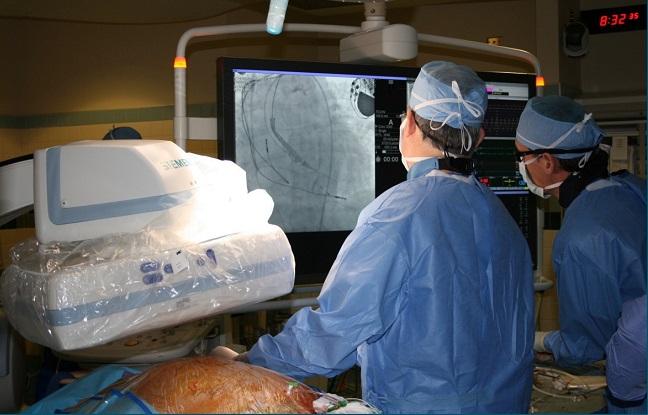Clinical Outcomes With Subclavian TAVR as Good as With Transfemoral Access, Small Analysis Shows
Although the numbers are small, they support the idea that the subclavian approach should be the preferred alternate access site for TAVR, say experts.

Patients with aortic stenosis who undergo transcatheter aortic valve replacement via the subclavian and femoral arteries have equivalent clinical outcomes at 30 days and 1 year, according to a new analysis.
The results, say investigators, suggest that the subclavian artery should be the access site of choice if physicians are unable to perform the procedure via the femoral artery.
“If you have adequate iliofemoral access, the first choice would still typically be transfemoral, but for those cases where there is inadequate access—either due to size, tortuosity, or atherosclerotic disease—then you could go the subclavian route,” lead investigator Thomas Gleason, MD (University of Pittsburgh Medical Center, PA), told TCTMD. “The outcomes were identical in nearly every category.”
The study, presented this week at the Society of Thoracic Surgeons (STS) annual meeting in Houston, TX, included patients participating in the CoreValve US Pivotal Trial program. In total, 202 patients who received the self-expanding CoreValve device (Medtronic) were treated via subclavian access and propensity-matched with 202 patients treated with the transfemoral approach.
At 30 days, all-cause mortality was 5.4% among patients treated via subclavian access and 5.9% in those treated via the femoral artery (P = 0.83). Rates of major stroke and reintervention also were equivalent between the two groups, as were those of major vascular complications, bleeding, acute kidney injury, and need for a permanent pacemaker.
At 1 year, mortality rates were 23.3% and 24.8% in the subclavian arm and in the transfemoral arm (P = 0.70), respectively, with no differences in stroke and reintervention rates. There was a trend toward less need for a permanent pacemaker with subclavian access at 1 year, but the difference compared with transfemoral access was not statistically significant.
Given the results, Gleason told TCTMD other alternate access-site options, such as direct access via the aorta (transthoracic) and transapical TAVR, which are associated with a higher risk of complications and mortality compared with the transfemoral approach, should now be considered “obsolete.”
Maybe Not Obsolete but Definitely Third-Tier
Howard Herrmann, MD (University of Pennsylvania, Philadelphia), who was not involved with the study, said the subclavian approach has become a popular access site for physicians, with most clinical centers opting to go this route if transfemoral access fails. “It’s becomes important to have an alternative access site for that 5% to 10% of cases and to also have confidence in the ability to use that site so that you’re not using five different sites 1% of the time,” he said.
Regarding other access routes, Herrmann wouldn’t go as far as calling them obsolete. “There are patients in whom you have neither subclavian nor transfemoral access,” he said. “So, 'obsolete implies you never do it, but I would probably say they’re third options. I definitely agree that subclavian is preferred, in my view, to direct aortic and transapical if both are feasible. But we still do an occasional transapical TAVR if we don’t have access to the subclavian artery.”
Also casting a strong vote in favor, Hiram Bezerra, MD (UH Cleveland Medical Center, OH), said that while the vast majority of their TAVR procedures are performed with femoral access, the subclavian route is their preferential secondary choice followed by the transapical approach. In contrast with these other approaches, though, transfemoral TAVR is a routine cath-lab procedure that offers advantages over alternative access sites.
“When you go to any alternate access site, it adds complexity as far as [operating room] time, or hybrid lab time, and the need for general anesthesia,” Bezerra told TCTMD. “That’s why we push 95% of our volume via the transfemoral.”
For other sites that might perform a larger percentage of their TAVR procedures under general anesthesia, the penalty they pay for using the subclavian artery is minimal, he said. He suspects, however, that transfemoral TAVR will continue to grow and dominate, particularly with the introduction of next-generation devices with lower profiles and the eligibility of lower-risk patients.
He noted that most subclavian-access experience is with CoreValve and Evolut R (Medtronic), but, at least in theory, the Sapien valve (Edwards Lifesciences) can also be implanted via the subclavian artery. Most physicians tend to combine alternate-access TAVR with specific valves, delegating the Sapien valve for the transapical approach and CoreValve for the subclavian route, he said.
To TCTMD, Herrmann noted there are some drawbacks with the subclavian approach. It is a smaller artery—one of the advantages of CoreValve in this setting is that it is preloaded on the delivery system as opposed to Sapien, which requires “some assembly” inside the vessel. It’s also possible for transient ischemia to develop as the sheath and device cross the subclavian into the aorta. Bezerra said if the subclavian artery is used, it is usually the left vessel because the angle of attack/angulation of the valve is better from the left side. The right subclavian supplies the right carotid, which means there is the theoretical potential of a higher risk of stroke, although this has not been shown, said Bezerra.
Photo credit: Thomas Gleason, MD
Michael O’Riordan is the Managing Editor for TCTMD. He completed his undergraduate degrees at Queen’s University in Kingston, ON, and…
Read Full BioSources
Gleason TG, Schindler J, Hagberg RC, et al. Subclavian access for self-expanding transcatheter aortic valve replacement equivalent outcomes as transfemoral. Presented at: Society of Thoracic Surgeons Meeting 2017. January 24, 2017. Houston, TX.
Disclosures
- Gleason reports research grant support from Medtronic.
- Herrmann reports institutional grant/research support from Abbott Vascular, Edwards Lifesciences, St. Jude Medical, Medtronic, Gore, Siemens, Bayer, Boston Scientific, Regado Biosciences, Cordis, Cardiokinetx, University of Laval, Mitraspan, and Coriva Medical. He consults for Edwards Lifesciences.
- Bezerra reports consulting for St. Medical.


Comments